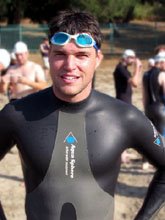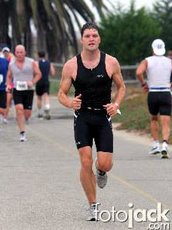A few weeks back Lou Schuler blogged about a study, which indicated, in short, that Shoes are Bad. The evidence is fairly convincing: examining the bones in the feet of a few thousand cadavers, researchers discovered that the feet of indigenous peoples, and others whose footwear was typically minimal, were far healthier than those of Europeans who spent their lives with their feet swathed in stiff leather.
It probably comes as no surprise that high heels are rough on feet, but plain ol’ regular shoes? Who knew?
Because I’m a runner (a fact I will continue to proclaim with pride despite the efforts of some fitness luminaries to brand me and my endurance-athlete brethren with a scarlet ‘EA’ across my chest), I usually wear thick-soled running shoes while training others or working out myself. I mean, how many pair of athletic shoes does one guy need?
But given the results of the study, I was curious. I’ve also been on a ‘rehab’ kick in my own workouts after a year or so of unusually intense pounding in the weight room, so I wondered if going barefoot, or at least minimally shoed, might help to clear up some of the soft-tissue and joint issues I’d been developing as I attempted to add some muscular weight to my frame.
So I ventured out one day in my falling-apart running shoes to a store called A Snail’s Pace, where let it be known the service was terrific: friendly, knowledgeable, and, I discovered after a few pointed questions, on the whole, extremely fleet of foot.
I walked out of the store with a new pair of running shoes and an additional pair of shoes called Nike Frees, which are built with the geniuses at Nike call “barefoot technology.”
Leave it to Nike to latch onto mounting evidence that shoes are bad for your feet and use that same evidence…to sell shoes. Geniuses indeed.
As you can see, though, I completely fell for it. And I have to say: they work. I don’t think I’ve ever had a pair of shoes that I noticed as feeling good, bad or indifferent after two or three wearings. But it’s now been about two weeks, and these babies still feel fantastic. I’ve worn them to work out; I’ve worn them on walks; I’ve worn them training clients, I’ve even worn them doing brief runs. Heck, I’m wearing my Nike Frees right now, sitting in a municipal building waiting for my number to come up for jury service, and they’re making my time here just a weeeee bit less miserable. As a wise man once said, the blog must go on.
Now, I don’t want to come across as a zealot or anything, but I would have to add that I also feel better in general: my back pain has subsided, my knees are feeling better. I’m less creaky. True, I’ve been hitting up the foam roller, and reorganizing my workouts to include more stretching and less hardcore pounding, but I’m convinced the shoes have helped.
It may not be cool to love on the corporate giants (especially ones with some questionable labor practices, which I'm just now finding out about, ugh) but when they get something right, you gotta give them their props. As far as my trotters are concerned, Nike knocked this one outta the park.
As Lou Schuler wrote, Tivo has a shoe called the Barefoot which operates on much the same premise: that the best way to promote foot health is to encourage the foot do what it wants to do naturally. I haven’t tried those yet, but if anyone has, hey, write in and let me know the skinny.
Thursday, May 29, 2008
Thursday, May 22, 2008
Old Dogs...
Back at Hanover High School I had a Latin instructor who said that teachers had to repeat themselves seven times before students would remember what they said. I don’t know where she came up with that number, but since then I’ve heard similar stats cited about sales—you need to hear about something seven times before you’ll buy it, or consider buying it, or even remember the name of the product or what it’s for. Sounds about right to me: there are just too many advertising messages out there begging for our attention for any one of them to capture our interest for long.
So a few days ago I was paging through a new book by fitness wunderkind Eric Cressey called Maximum Strength. In it Cressey opens his chapter on warm-ups by telling us how much sympathy he has for work-a-day dentists, who spend most of their careers exhorting patients to floss, only to have the same stubborn and oblivious patients come in after a few weeks or years with their teeth in need of serious and expensive help. Similarly, fitness folks spend a lot of time telling people to warm up and stretch, but no one really ever does, because they’re short on time and energy and want to jump right into their benchin’ and curlin’, man.
After my fourth or fifth excruciating lifting-induced back strain, I finally saw the light when it came to stretching, and started doing it religiously about ten years ago. But Cressey’s book finally convinced me to try foam rolling, a little pre-workout ritual I’ve been resisting for about six years. I’ve attended seminars on foam rolling, I’ve heard the pleas of uber-trainers Alwyn Cosgrove and Mike Boyle on the benefits of foam rolling, but I’ve never actually DONE or RECOMMENDED foam rolling myself because, well, it seemed like just one more hassle before I was allowed to get to the good stuff in my workouts.
Besides, all that scooting around on the floor doing questionable-looking things with a cushy cylindrical object just struck me as a mile or two too far down the Willing-To-Do-Anything-For-Fitness Freeway.
But somehow Cressey’s dentist-analogy finally got to me, and I started kicking off my workouts with a foam-rolling regimen early this week.
Hate to admit it, but it appears that Mike Boyle, Alywn Cosgrove, Eric Cressey, and Mike Clark, who runs the National Academy of Sports Medicine, from which I hold a certification, were all, surprisingly, correct: foam rolling feels great, instantly unkinks muscles, makes your workout, and athletic movement in general, easier. I noticed it when I sashayed myself into my microscopic Ford Escort after I left the gym. As relatively limber and athletic as I am, getting into that car can be a bit of a drag for a tallish, biggish guy like me. Not since I started foam rolling. Suddenly I move with the grace of a dancer.
Well, maybe not quite, but you get the idea. The effects are pretty much instantaneous, and certainly recognizable during your workout if you foam roll thoroughly before vigorous athletic movement.
Who knows what the long-term effects are, but if the acute effects of a five-minute full-body foam rolling session are any indication, I think I’ll have acquired the gift of flight by this time next year.
The humble but surprisingly effective foam roller is part of a relatively new movement in fitness that factors long-term health into the equation, rather than just seeking to shrink a woman to a size two before bathing suit season. There seems to be a much needed crop of smart trainers out there who are realizing that staying healthy and strong over several decades requires a more sophistocated body of knowledge and expertise than just getting in shape for the first time. Just in time, too, because my generation of fitness freaks--the ones raised on a steady diet of Weider-style bodybuilding concepts--are getting a little older. We're feeling a few more exercise-induced aches and pains and we're starting to wonder how we can stay in shape for another 50 years without grinding our joints into oblivion and, ironically, suffering the same, wheelchair-bound fate as our sedentary contemporaries whom we've treated with such scorn over the years.
So a few days ago I was paging through a new book by fitness wunderkind Eric Cressey called Maximum Strength. In it Cressey opens his chapter on warm-ups by telling us how much sympathy he has for work-a-day dentists, who spend most of their careers exhorting patients to floss, only to have the same stubborn and oblivious patients come in after a few weeks or years with their teeth in need of serious and expensive help. Similarly, fitness folks spend a lot of time telling people to warm up and stretch, but no one really ever does, because they’re short on time and energy and want to jump right into their benchin’ and curlin’, man.
After my fourth or fifth excruciating lifting-induced back strain, I finally saw the light when it came to stretching, and started doing it religiously about ten years ago. But Cressey’s book finally convinced me to try foam rolling, a little pre-workout ritual I’ve been resisting for about six years. I’ve attended seminars on foam rolling, I’ve heard the pleas of uber-trainers Alwyn Cosgrove and Mike Boyle on the benefits of foam rolling, but I’ve never actually DONE or RECOMMENDED foam rolling myself because, well, it seemed like just one more hassle before I was allowed to get to the good stuff in my workouts.
Besides, all that scooting around on the floor doing questionable-looking things with a cushy cylindrical object just struck me as a mile or two too far down the Willing-To-Do-Anything-For-Fitness Freeway.
But somehow Cressey’s dentist-analogy finally got to me, and I started kicking off my workouts with a foam-rolling regimen early this week.
Hate to admit it, but it appears that Mike Boyle, Alywn Cosgrove, Eric Cressey, and Mike Clark, who runs the National Academy of Sports Medicine, from which I hold a certification, were all, surprisingly, correct: foam rolling feels great, instantly unkinks muscles, makes your workout, and athletic movement in general, easier. I noticed it when I sashayed myself into my microscopic Ford Escort after I left the gym. As relatively limber and athletic as I am, getting into that car can be a bit of a drag for a tallish, biggish guy like me. Not since I started foam rolling. Suddenly I move with the grace of a dancer.
Well, maybe not quite, but you get the idea. The effects are pretty much instantaneous, and certainly recognizable during your workout if you foam roll thoroughly before vigorous athletic movement.
Who knows what the long-term effects are, but if the acute effects of a five-minute full-body foam rolling session are any indication, I think I’ll have acquired the gift of flight by this time next year.
The humble but surprisingly effective foam roller is part of a relatively new movement in fitness that factors long-term health into the equation, rather than just seeking to shrink a woman to a size two before bathing suit season. There seems to be a much needed crop of smart trainers out there who are realizing that staying healthy and strong over several decades requires a more sophistocated body of knowledge and expertise than just getting in shape for the first time. Just in time, too, because my generation of fitness freaks--the ones raised on a steady diet of Weider-style bodybuilding concepts--are getting a little older. We're feeling a few more exercise-induced aches and pains and we're starting to wonder how we can stay in shape for another 50 years without grinding our joints into oblivion and, ironically, suffering the same, wheelchair-bound fate as our sedentary contemporaries whom we've treated with such scorn over the years.
Subscribe to:
Comments (Atom)



